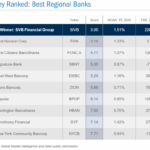The investment firm KBW has published its “Takeover List” in the U.S. banking sector after a gap of about two and half years. An article in The Wall Street Journal noted some of the reasons for the expected M&A activity include:
- A lack of earnings power
- Tough regulation on capital and use of debt
- More clarity on commercial real estate assets and other troubled loans on banks’ books
The takeover list is split into three categories:
- The KBW Potential Buyers List
- The KBW Potential Sellers List
- The KBW Potential Buyers Who Could Become Sellers List
The potential buyers include regional banks such as BB&T Corp (BBT), City National Corp (CYN), First Horizon National (FHN) and PNC Financial Services (PNC). The four “Too big to fail” super banks – Bank of America(BAC), JP Morgan Chase(JPM), Citibank(C) and Wells Fargo(WFC) are not in this list since they already at or near the regulatory limits on the share of U.S. deposits they are allowed to hold.
Of the 26 potential sellers, the following seven banks are attractive for buyers due to “a good footprint, more low-cost deposits and healthy fee-income businesses.”
- Abington Bancorp(ABBC) of PA
- Boston Private Financial Holdings(BPFH) of MA
- Cardinal Financial(CFNL)Â of VA
- Encore Bancshares(EBTX)Â of TX
- Susquehanna Bancshares(SUSQ) of PA
- Western Alliance Bancorporation(WAL) of NV
- Wilmington Trust(WL) of DE
These potential sellers have market caps of less than about $1B.
The top banks in the “Potential Buyers Who Could Become Sellers List” are:
- Bryn Mawr Bank (BMTC)
- Columbia Banking System (COLB)
- Citizens South Banking (CSBC)
- First Financial Holdings (FFCH)
- First Midwest Bancorp (FMBI)
- MB Financial (MBFI)
- PacWest Bancorp (PACW)
It must be noted that so far this year 86 banks have failed and the number of “problem banks” has reached 775 according to the FDIC. Some of the markets have way too many than needed. Hence there is plenty of room for consolidation in the highly fragmented U.S. banking industry.

